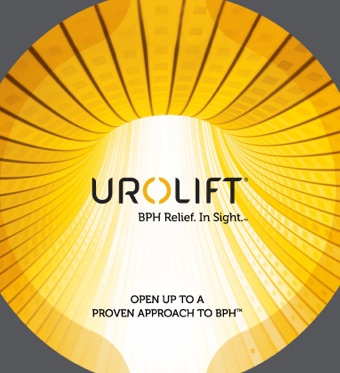Section 01
Enlarged prostate sufferers have historically had to choose between maintenance medications that may not work and invasive surgical procedures—most with the risk of undesirable side effects.
The UroLift® System is an early treatment option for BPH — with no cutting, heating or removal of prostate tissue, providing faster recovery with fewer risks.
UroLift may be the right treatment option for men seeking a solution that:
UroLift-trained urologists in your area can assess if the UroLift System is right for your patient.
A recent study in the Journal of Urology showed a clear association with alpha-blockers and new reports of heart failure. Read more about the study in this Urology Times article.

What is the UroLift System?
The right solution for many BPH patients
Clinical data and durability
Section 01
The UroLift System uses a revolutionary approach to treating BPH that lifts and holds the enlarged prostate tissue out of the way, so it no longer blocks the urethra. It is the only transurethral BPH treatment that does not require ongoing medication, heating, cutting or removal of the prostate tissue.

Click through the steps below to see how the UroLift System simply reopens the channel.
Go to step 1 >The UroLift® Delivery Device is placed through the obstructed urethra to access the enlarged prostate.
Go to step 2 >Small UroLift implants are permanently placed to lift and hold the enlarged prostate tissue out of the way and increase the opening of the urethra.
Go to step 3 >The UroLift Delivery Device is removed, leaving an open urethra designed to provide symptom relief.
Section 02
Quality of life and overall health are important considerations in treating BPH. Watchful waiting can risk bladder health. Medications can cause bothersome side effects and often fail to provide significant symptom relief.





Men with BPH:
TURP or Laser Candidates:

Donec ullamcorper nulla non metus auctor fringilla. Cras mattis consectetur purus sit amet fermentum. Lorem ipsum dolor sit amet, consectetur adipiscing elit.
See full safety statement at UroLift.com/Patient-Safety.

Section 03
Compared to medications, the UroLift System has demonstrated a much more positive effect on quality of life for patients.1 The UroLift System treatment preserves sexual function and avoids complications typically associated with other BPH procedures.1,2

Improvement in LUTS, as seen through average reduction in IPSS (International Prostate Symptom Score), has been consistent across the various studies, showing rapid relief within two weeks and sustained effect through five years.1 IPSS improvement at one year is better than seen with medications.2,4
Quality of life also improved significantly, with the IPSS QOL and BPH Impact Index maintaining 50% and 52% improvements, respectively at five years, p<0.0001.1
In addition to improving LUTS, the UroLift System treatment has demonstrated significant average improvement in peak urinary flow rate (Qmax) of 3.5 mL/sec (44%) that was sustained to five years, p<0.0001. 1
The rate of surgical intervention for failure to cure with the UroLift System remains low for a BPH procedure, with approximately 13.6% over five years or about 2-3% per year.1 Over the first postoperative year, no additional surgical intervention was required for bladder neck contracture, bleeding, or stress incontinence in the pivotal study on UroLift System.4

The UroLift System treatment is the only leading BPH procedure shown not to cause new and lasting sexual dysfunction* 2,4,21 UPDATE REFERENCES AT BOTTOM

Clinical results from over 28 peer-reviewed publications demonstrate that treatment with the UroLift System offers rapid and significant improvements in symptoms, urinary flow and quality of life sustained through five years.
© 2025 All rights reserved. | Terms of Use | Privacy Policy | Patient Safety